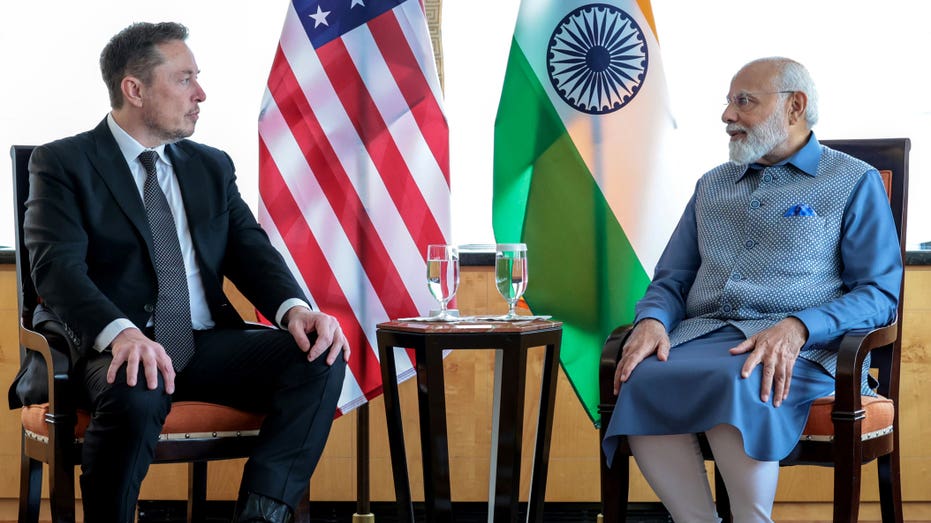President Donald Trump is expected to welcome Indian Prime Minister Narendra Modi to the White House on Thursday. As only the fourth world leader to meet with the president since beginning his second term, the meeting underscores the importance of the U.S.-India relationship.
Modi, India’s most prominent leader in decades, remains a largely popular yet polarizing figure both at home and abroad. Officials in New Delhi are optimistic that his visit will pave the way for a renewed strategic partnership. Trump and Modi are expected to cover a broad range of issues; trade and tariffs are expected to dominate it.
Reuters reported that Modi is also expected to meet with billionaire tech CEO Elon Musk, whose Starlink’s entry to the South Asian market could be discussed. The two men are said to have a friendly relationship, with Musk meeting Modi in 2023.
“Trade is by far the most important agenda, with defense and foreign policy taking a secondary position this time around,” Siddhartha Dubey, a visiting professor of journalism at Bennett University in India, told FOX Business. The countries have “no progress on a trade deal,” he said.
India, the world’s fastest-growing major economy, has been spared any tariffs so far. But the stakes remain elevated.
INDIA’S MODI SPEAKS WITH ‘DEAR FRIEND’ PRESIDENT TRUMP AMID HOPES OF FURTHERING TIES
“This has been one of our strongest international partnerships in recent years,” Dubey said.
Trump and Modi enjoy a strong personal rapport, and their meeting is expected to shed more light on the evolving dynamics between the world’s most populous democracy and its most powerful one,
The U.S. is India’s largest trading partner, with trade reaching a record $129.2 billion in 2024. Currently, the trade surplus is around $35 billion in India’s favor. India is also one of the most protectionist economies, and Trump is sure to press for more access.
Dubey warned that “privately, many Indians feel Delhi could be in Trump’s crosshairs soon,” especially with the news of Trump saying he will implement reciprocal tariffs on any countries with tariffs on U.S. goods, which could include India. And most recently, he introduced a 25% tariff on all steel and aluminum imports with no exceptions. But Modi is keen to avert a potential trade war. Over the next few days, he is expected to offer some major concessions in an attempt to move toward what the White House calls a “fair bilateral trading relationship.”
India is already showing a willingness to ease its own tariffs in what are believed to be preemptive moves to stave off U.S. tariffs. India has slashed duties on key U.S. exports. This month, for example, India cut tariffs on motorcycles in a move that benefits American company Harley-Davidson. U.S. motorcycle exports to India amounted to only about $3 million last year.
INDIAN PRIME MINISTER MODI’S 3RD-TERM VICTORY A WIN FOR BUSINESS: ‘THE SKY IS THE LIMIT’

Despite the steps India has taken to address Trump’s concerns, the country remains at risk. Trump has often criticized India as being one of the “very big tariff abusers,” and just last month he called the nation a “tremendous tariff maker.”
Trump’s top economic adviser, Kevin Hassett, echoed those criticisms on Monday, saying “India has enormously high” tariffs that act as an import barrier. During his first term, Trump railed against India’s steep tariffs, dubbing it a “tariff king.” In 2019, he revoked India’s special trade privileges, prompting India to retaliate by slapping tariffs on dozens of U.S. goods.
According to World Trade Organization data, India’s simple average tariff rate is 17%, significantly higher than the U.S. rate of about 3.3%.
“This is unfair,” Dubey told FOX Business. “And I do not believe that President Trump will turn a blind eye. India has to cut its high tariffs, there’s no question about it,” he added.
Nonetheless, India remains confident in being able to navigate Trump’s “America First” policies. During the upcoming meeting, Modi is anticipated to propose an increase in energy product imports from the U.S. to address the trade imbalance. India’s oil secretary says companies there are hoping to purchase U.S. liquefied natural gas after Trump lifted a ban on new export permits. As the fourth-largest importer of liquefied natural gas, India is well-positioned to further its energy trade with the U.S.
When it comes to defense imports, Reuters reports that Modi is negotiating the purchase and co-production of combat vehicles as well as finalizing a fighter jet engine deal. India is the world’s largest importer of military equipment, and Trump wants the country to buy more U.S.-made security equipment. The push comes as the U.S. and Russia are competing to secure India’s fifth-generation fighter jet deal. New Delhi is also focused on attracting greater investment from U.S. companies in manufacturing and services, particularly the insurance sector.
Modi arrived in Washington on Wednesday after a visit to France for a global conference on artificial intelligence. During his time there, Modi met with Vice President JD Vance, further strengthening diplomatic ties. In a departure statement, Modi expressed eagerness for his meeting with “my friend, President Trump,” which is sure to present both opportunities and challenges.
Indo-U.S. trade ties have grown steadily over the years, but Modi has acknowledged that the partnership can be deepened in several critical areas, including technology, trade, defense, energy and supply chain resilience.
“Modi and his team need to do more to assuage Trump and his team that they will lift certain duties and make India a whole lot friendlier to U.S. exporters,” Dubey said.
Read the full article here


